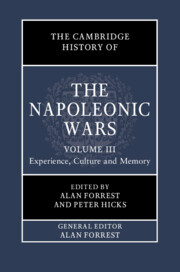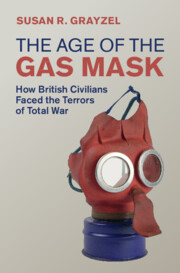Refine search
Actions for selected content:
15401 results in Military history
3 - Defending Civilians
-
- Book:
- The Age of the Gas Mask
- Published online:
- 21 July 2022
- Print publication:
- 11 August 2022, pp 49-88
-
- Chapter
- Export citation
2 - Inventing an Object for Modern Conflict
-
- Book:
- The Age of the Gas Mask
- Published online:
- 21 July 2022
- Print publication:
- 11 August 2022, pp 15-48
-
- Chapter
- Export citation
5 - Curating the Good Citizen
-
- Book:
- The Age of the Gas Mask
- Published online:
- 21 July 2022
- Print publication:
- 11 August 2022, pp 128-173
-
- Chapter
- Export citation
Acknowledgments
-
- Book:
- The Age of the Gas Mask
- Published online:
- 21 July 2022
- Print publication:
- 11 August 2022, pp x-xiii
-
- Chapter
- Export citation

The Cambridge History of the Napoleonic Wars
-
- Published online:
- 05 August 2022
- Print publication:
- 09 June 2022

The Age of the Gas Mask
- How British Civilians Faced the Terrors of Total War
-
- Published online:
- 21 July 2022
- Print publication:
- 11 August 2022
3 - Redefining the Jewish Past: Vladimir Vertlib
-
- Book:
- Transcultural Memory and European Identity in Contemporary German-Jewish Migrant Literature
- Published by:
- Boydell & Brewer
- Published online:
- 07 October 2022
- Print publication:
- 19 July 2022, pp 71-104
-
- Chapter
- Export citation
Part II - Imaginations of Europe: Nazism and Stalinism Rethought
-
- Book:
- Transcultural Memory and European Identity in Contemporary German-Jewish Migrant Literature
- Published by:
- Boydell & Brewer
- Published online:
- 07 October 2022
- Print publication:
- 19 July 2022, pp 69-70
-
- Chapter
- Export citation
Dedication
-
- Book:
- Transcultural Memory and European Identity in Contemporary German-Jewish Migrant Literature
- Published by:
- Boydell & Brewer
- Published online:
- 07 October 2022
- Print publication:
- 19 July 2022, pp v-vi
-
- Chapter
- Export citation
Conclusion
-
- Book:
- Transcultural Memory and European Identity in Contemporary German-Jewish Migrant Literature
- Published by:
- Boydell & Brewer
- Published online:
- 07 October 2022
- Print publication:
- 19 July 2022, pp 250-256
-
- Chapter
- Export citation
5 - The East-West Division through the Lens of the Divided Germany: Barbara Honigmann
-
- Book:
- Transcultural Memory and European Identity in Contemporary German-Jewish Migrant Literature
- Published by:
- Boydell & Brewer
- Published online:
- 07 October 2022
- Print publication:
- 19 July 2022, pp 142-176
-
- Chapter
- Export citation
Introduction: Writing against the Backdrop of European Memory Politics after 1989
-
- Book:
- Transcultural Memory and European Identity in Contemporary German-Jewish Migrant Literature
- Published by:
- Boydell & Brewer
- Published online:
- 07 October 2022
- Print publication:
- 19 July 2022, pp 1-28
-
- Chapter
- Export citation
7 - Dichotomy as a Principle of Mnemonic Migration: Lena Gorelik
-
- Book:
- Transcultural Memory and European Identity in Contemporary German-Jewish Migrant Literature
- Published by:
- Boydell & Brewer
- Published online:
- 07 October 2022
- Print publication:
- 19 July 2022, pp 211-249
-
- Chapter
- Export citation
Acknowledgments
-
- Book:
- Transcultural Memory and European Identity in Contemporary German-Jewish Migrant Literature
- Published by:
- Boydell & Brewer
- Published online:
- 07 October 2022
- Print publication:
- 19 July 2022, pp ix-x
-
- Chapter
- Export citation
Part III - Contesting Germany’s Social Framework of Memory
-
- Book:
- Transcultural Memory and European Identity in Contemporary German-Jewish Migrant Literature
- Published by:
- Boydell & Brewer
- Published online:
- 07 October 2022
- Print publication:
- 19 July 2022, pp 177-178
-
- Chapter
- Export citation
6 - Traumatic Recollections: Olga Grjasnowa
-
- Book:
- Transcultural Memory and European Identity in Contemporary German-Jewish Migrant Literature
- Published by:
- Boydell & Brewer
- Published online:
- 07 October 2022
- Print publication:
- 19 July 2022, pp 179-210
-
- Chapter
- Export citation
Index
-
- Book:
- Transcultural Memory and European Identity in Contemporary German-Jewish Migrant Literature
- Published by:
- Boydell & Brewer
- Published online:
- 07 October 2022
- Print publication:
- 19 July 2022, pp 281-285
-
- Chapter
- Export citation
About the Cover Image
-
- Book:
- Transcultural Memory and European Identity in Contemporary German-Jewish Migrant Literature
- Published by:
- Boydell & Brewer
- Published online:
- 07 October 2022
- Print publication:
- 19 July 2022, pp xi-xi
-
- Chapter
- Export citation
Bibliography
-
- Book:
- Transcultural Memory and European Identity in Contemporary German-Jewish Migrant Literature
- Published by:
- Boydell & Brewer
- Published online:
- 07 October 2022
- Print publication:
- 19 July 2022, pp 257-280
-
- Chapter
- Export citation
List of Abbreviations
-
- Book:
- Transcultural Memory and European Identity in Contemporary German-Jewish Migrant Literature
- Published by:
- Boydell & Brewer
- Published online:
- 07 October 2022
- Print publication:
- 19 July 2022, pp xii-xii
-
- Chapter
- Export citation
